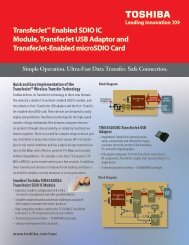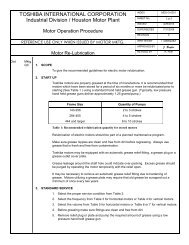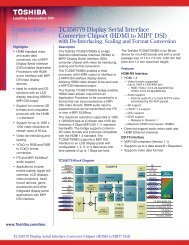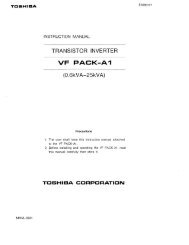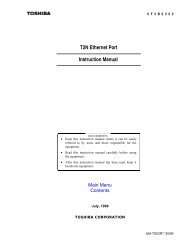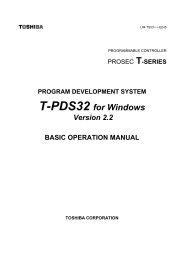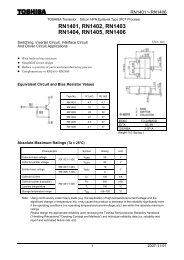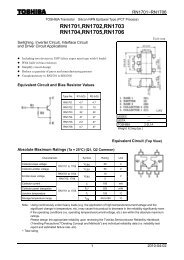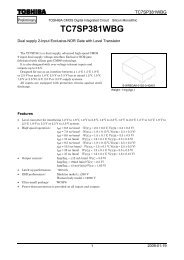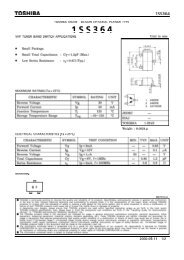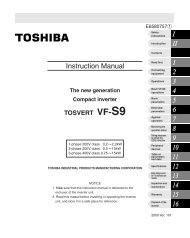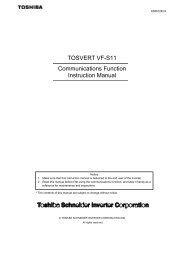VF-FS1 Industrial Inverter - Toshiba
VF-FS1 Industrial Inverter - Toshiba
VF-FS1 Industrial Inverter - Toshiba
Create successful ePaper yourself
Turn your PDF publications into a flip-book with our unique Google optimized e-Paper software.
13.4 How to determine the causes of other problems<br />
The following table provides a listing of other problems, their possible causes and remedies.<br />
Problems Causes and remedies<br />
The motor runs in the<br />
wrong direction.<br />
The motor runs but its<br />
speed does not change<br />
normally.<br />
The motor does not<br />
ac-celerate or decelerate<br />
smoothly.<br />
A too large current flows<br />
into the motor.<br />
The motor runs at a higher<br />
or lower speed than the<br />
specified one.<br />
The motor speed fluctu-ates<br />
during operation.<br />
Parameter settings cannot<br />
be changed.<br />
How to cope with parameter setting-related problems<br />
If you forget parameters<br />
which have been reset<br />
If you want to return all<br />
reset parameters to their<br />
respective default settings<br />
M-7<br />
E6581381<br />
• Invert the phases of the output terminals U, V and W.<br />
• Invert the forward/reverse run-signal terminals of the external input device.<br />
⇒ See section 6.3 "Assignment of functions to control terminals".<br />
• Change the setting of the parameter in the case of panel operation.<br />
• The load is too heavy. Reduce the load.<br />
• The soft stall function is activated. Disable the soft stall function. ⇒ See section 5.12.<br />
• The maximum frequency and the upper limit frequency are set too low.<br />
Increase the maximum frequency and the upper limit frequency .<br />
• The frequency setting signal is too low. Check the signal set value, circuit, cables, etc.<br />
• Check the setting characteristics (point 1 and point 2 settings) of the frequency setting<br />
signal parameters. ⇒ See section 6.5.<br />
• If the motor runs at a low speed, check to see that the stall prevention function is<br />
activated because the torque boost amount is too large.<br />
Adjust the torque boost amount () and the acceleration time ().<br />
⇒ See section 5.11 and 5.1.<br />
• The acceleration time () or the deceleration time () is set too short.<br />
Increase the acceleration time () or the deceleration time ().<br />
• The load is too heavy. Reduce the load.<br />
• If the motor runs at a low speed, check whether the torque boost amount is too large. ⇒<br />
⇒ See section 5.11.<br />
• The motor has an improper voltage rating. Use a motor with a proper voltage rating.<br />
• The motor terminal voltage is too low.<br />
Check the setting of the base frequency voltage parameter () .<br />
⇒ See section 6.12.5.<br />
Replace the cable with a cable larger in diameter.<br />
• The reduction gear ratio, etc., are not set properly. Adjust the reduction gear ratio, etc.<br />
• The output frequency is not set correctly. Check the output frequency range.<br />
• Adjust the base frequency. ⇒ See section 5.9.<br />
• The load is too heavy or too light. Reduce the load fluctuation.<br />
• The inverter or motor used does not have a rating large enough to drive the load.<br />
Use an inverter or motor with a rating large enough.<br />
• Check whether the frequency setting signal changes.<br />
• If the V/F control selection parameter is set at , check the vector control setting,<br />
operation conditions, etc. ⇒ See section 5.10.<br />
Change the setting of the parameter (prohibition of change of parameter<br />
setting) to (permitted) if it is set at (prohibited).<br />
* For reasons of safety, some parameters cannot be reprogrammed while the inverter is<br />
running. ⇒ See section 4.2.6.<br />
• You can search for all reset parameters and change their settings.<br />
⇒ See section 4.2.3 for details.<br />
• You can return all parameters which have been reset to their default settings.<br />
⇒ See section 4.2.7 for details.<br />
13



